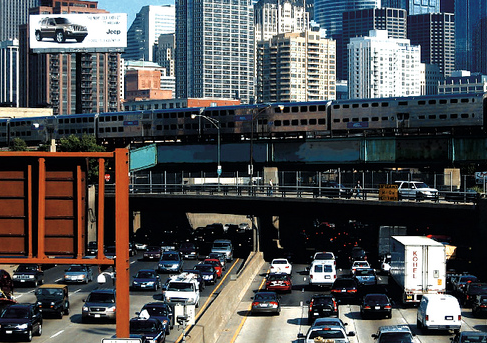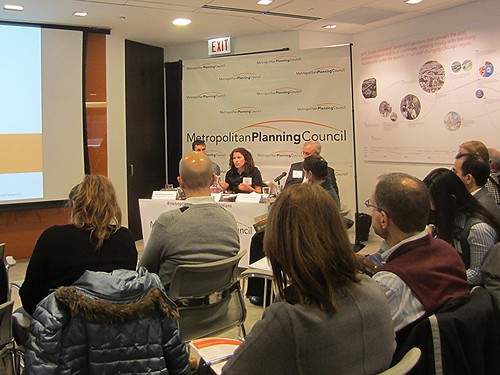Traffic jams cost Chicagoland residents more than $7.3 billion every year in wasted time and fuel, according to the Metropolitan Planning Council’s 2008 report “Moving at the Speed of Congestion.” And we're not headed in the right direction: The share of drive-alone commuters in the region increased from 46 percent to 51 percent from 1990 to 2008.
This is “not a sustainable trend, not something we want to see continue in the future,” said MPC executive vice president Peter Skosey in his opening remarks at Friday’s Making the Case for Commute Options roundtable.
“Employers are a great way to reach employees and begin to change some of these patterns,” Skosey said. “Indeed, that’s what MPC embarked on a couple years ago.” The event unveiled the organization's report, “Chicago Demands Transportation Management: The Case for TDM in Chicagoland.” TDM, short for "transportation demand management," strengthens commute options other than driving alone. And in 2014 MPC wants to promote a region-wide TDM program, in partnership with agencies like the Regional Transportation Authority.
The three speakers Friday included Kate Gantzer-Hayes from Goose Island Beer Company, David Kleinwachter from Christopher Burke Engineering, and Thomas Cerny, director of TDM services for URS Corporation, a transportation engineering firm.
In 2011 and 2012, MPC ran a pilot TDM program called Commute Options, tailoring surveys for 16 different companies across the region, as well as recommendations to cut single-occupant vehicle usage. MPC then conducted another survey to assess changes. Goose Island and Christopher Burke Engineering were two of participating companies.
“My office is trying to lead by example,” Kleinwachter said. “We’re trying to be the shining star for offices around us.” His firm is located in Rosemont, less than a mile from the eponymous Blue Line stop and less than three miles from four Metra stops. However, last-mile connections are lacking. “We are surrounded by pavement,” he said. “It’s easy to see why people travel here by car. It’s accessible [by car] from every direction.” According to survey results, 80 percent of employees drive five days a week.

Located in the West Loop, Goose Island’s flexible work hours offered both challenges and opportunities. “We have a lot of [people] in and out [of the office] at different times,” Gantzer-Hayes said. “That affected our ability to do things like carpooling.”
As a whole, the pilot showed an average 10-percent decrease in drive-alone rates among participating employees. Once the companies found out why staff members drove to work alone, they could come up with strategies to encourage change. For example, both company reps said they discovered employees need to use cars for work tasks throughout the day, not just for getting to work. In response, Christopher Burke set aside parking spaces to house five I-GO car-sharing vehicles. This frees up employees from having to drive a car to work, since they know they can check out a vehicle for work trips when necessary.
The survey revealed that the barriers to bike commuting to Goose Island’s West Loop brewery were very low, Gantzer-Hayes said. “Some people didn't want to leave their bike because of where the bike rack was,” she said. “It was out of the field of vision. We moved it 15 feet and now people put their bikes on it." Every third month or so, bike mechanics set up shop on the loading dock during lunch hour, fixing flats and doing other basic repairs for employees.
Both companies increased the frequency of "lunch and learn" events and promotional activities to teach employees about topics such as pre-tax benefits for transit use. The RTA website calls this "transit's best kept secret." Employees can use pre-tax deductions from their paycheck to cover transit fares. After participating in the pilot program, 64 percent of Christopher Burke employees said they knew about pre-tax benefits for transit, up from the original 39 percent. Meanwhile, Goose Island is looking into Divvy membership for their employees and other ideas to make their Green Steps sustainability program "bigger, better, and bolder," Gantzer-Hayes said.
In 2012, Christopher Burke employees pedaled the equivalent of nine times around the Earth while biking to work. The firm even paid employees 75 cents per mile to bike commute. Cerny said financial incentives like this are an effective way to change behavior. "You can buy people out of their cars," he said. Participants in Atlanta's Clean Air Campaign, which he helped set up, were paid $2 per day over three months to use modes other than cars to commute. "Two years after incentives stopped, over 50 percent were still using an alternative mode."
An effective video promoting carpooling from Atlanta's Clean Air Campaign
The MPC report details other best practices, including the importance of displaying real-time transit information and providing last-mile options for the gap between transit stations and suburban workplaces. Christopher Burke is looking beyond their office to work with the Village of Rosemont and the Chicago Metropolitan Agency for Planning to make the local train and bus stops more accessible via walking and biking. The Active Transportation Alliance is helping to map existing conditions and recommended routes, and will provide Bike Ambassadors at events.
Cerny, who does TDM consulting in nine states, said that when it comes to launching a region-wide program, "I strongly suggest going big. Go big or go home." For example, the Atlanta campaign involved more than 1,600 employers. This "TDM on steroids" receives $11 million per year in funding and is probably the most evaluated program in the country, because the large amount of money invested means there’s "a significant amount of scrutiny, which is appropriate," Cerny added. As a result, local streets are spared 1.5 million miles of drive-alone travel each day. “That’s a larger [distance than] some commuter assistance programs pull off in an entire year.”
MPC recommends using a million dollars in federal Congestion Mitigation and Air Quality funding currently designated for use by the RTA for TDM, plus a portion of sales tax proceeds, to establish the Chicagoland program. There’s also an opportunity for the Illinois Department of Transportation to use general funds and "see how they can learn from the [Chicago] program and expand it to other regions in the state," Skosey said.
"TDM should not be an outlier,” Cerny emphasized. “It should be funded as fairly as the rest of the transportation system. I'd much rather see the money put into incentives and outreach. We've found generally that money on public relations-type activities is better spent than just on advertisements."
When assessing performance, the decrease in drive-alone commutes should be of highest importance. "There can be a lot of [unwarranted] warm fuzzy with TDM,” Cerny warns. “Let's make sure it's not just about feeling good about the number of coffee mugs you hand out, but about the number of cars you take off the road."






